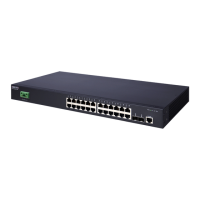Chapter 20
| ERPS Commands
– 526 –
Default Setting
None
Command Mode
Global Configuration
Command Usage
◆ Service Instances within each ring are based on a unique maintenance
association for the specific users, distinguished by the ring name, maintenance
level, maintenance association’s name, and assigned VLAN. Up to 6 ERPS rings
can be configured on the switch.
◆ R-APS information is carried in an R-APS PDUs. The last octet of the MAC
address is designated as the Ring ID (01-19-A7-00-00-[Ring ID]). If use of the
default MAC address is disabled with the no raps-def-mac command, then the
Ring ID configured by the erps domain command will be used in R-APS PDUs.
Example
Console(config)#erps domain r&d id 1
Console(config-erps)#
control-vlan This command specifies a dedicated VLAN used for sending and receiving ERPS
protocol messages. Use the no form to remove the Control VLAN.
Syntax
[no] control-vlan vlan-id
vlan-id - VLAN ID (Range: 1-4093)
Default Setting
None
Command Mode
ERPS Configuration
Command Usage
◆ Configure one control VLAN for each ERPS ring. First create the VLAN to be used
as the control VLAN (vlan, page 563), add the ring ports for the east and west
interface as tagged members to this VLAN (switchport allowed vlan, page 566),
and then use the control-vlan command to add it to the ring.
◆ The following restrictions are recommended to avoid creating a loop in the
network or other problems which may occur under some situations:
■
The Control VLAN must not be configured as a Layer 3 interface (with an IP
address), nor as a dynamic VLAN (with GVRP enabled).
